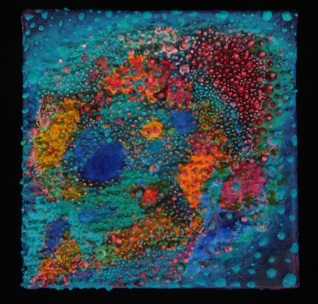
In the Pacific Northwest, totem poles are a part of the collective imagination. Majestic cedar poles aged and carved by First Peoples stud the coastal areas of Washington and Oregon all the way to Alaska and Canada.
But hey, what about that wooden bear ripped-by-chainsaw from a tree stump in some white guy’s front yard in Hoquiam? Is that a kind of “totem,” too? Does it express an unconscious yearning to tell a personal story; to broadcast the myths of the family clan?

Tacoma artist Elise Richman seems to pose this question and others with her site-specific art installation, Spring Mascot, at the Woolworth Building. This whimsical, totem-inspired work is unique in both its composition (colorful bird sculptures and large bird paintings are spread out horizontally across the window instead of vertically in a pole configuration), and personal point of view: among other things, the gawky avian entities represent a tribute to “the often taken-for-granted heroics of caregivers and nurturers.”
Richman traveled to Alert Bay in British Columbia last summer to research totem poles. She was compelled “by their seemingly animated designs and vivid visual narratives. Totem poles loom and confront with an arresting and powerful presence.” Yet her sculptures vibrate on a surprisingly different, more delicate frequency than the stolid entities from centuries past.
“My bird paintings and sculptures act as surrogate self-portraits and guardian figures….[They] embody an openness and vulnerability that I value. Their gestures [and] postures are confident but also awkward. They model and defend the kind of receptivity that is only possible when we face the world with as much care, honesty, and hope as we can muster. The birds guard the act of letting one’s guard down.”

Indeed, the birds in Spring Mascot capture the uncertainty, humor and possibility of embarrassment that surround first flights. Their coats of thick, dimensional feathers have “the consistency and look of frosting but are prickly to the touch, creating an appealing yet protective armor of sorts. They have something in common with multi-media artist Nick Cave’s ‘Sound Suits’ in that he transforms discrete objects into ‘skins’.”
Birds have provided the artist with inspiration for years. “I was struck by the individuality and seemingly needless beauty of songbirds and waterfowl during daily walks to my studio as a graduate student [at the American University] in Washington, DC,” she says.
Richman’s field work at Alert Bay, on Cormorant Island, brought her into contact with birds again. “Cormorant Island could be called ‘Raven Island’. Hundreds of ravens populate the island. No other animals live on the island. The ravens animate the trees and the sky.” In addition, there is a Namgis (First Nations tribe) burial ground at Alert Bay, “One of just a handful of sites featuring totem poles in their original, intended location. The totem poles face water, the Inside Passage.” The carved works’ “striking, stacked animal spirits, including birds such as ravens and eagles, act as guardians and symbols of tribes, families, and individuals.”
The word totem comes from an Ojibwe term, odoodem, meaning “his kinship group”. Richman’s birds, with their open sense of humanity, embody the spirit of risktakers and newborns. They also hover brightly in contrast to the traditional “shame poles” that expose the foul behavior of individuals to public ridicule. The totem carved with the distorted face of ex-Exxon CEO, Lee Raymond, and erected in Cordova, AK, after the oil spill in Valdez, is an example of a shame pole.
Festooned with ribbons, yarn and silk flowers, Richman’s avian entities highlight the positive. “Thinking of the idea of totems as a woman, I consider the everyday, often taken-for-granted heroics of caregivers and nurturers. Love is expressed in the constancy and attentiveness of such individuals. Spring Mascot is meant to celebrate simple, affirming acts that make life special.” Spring Mascot by Elise Richman, at the Woolworth Building, 11th & Broadway, through June 30, 2012.